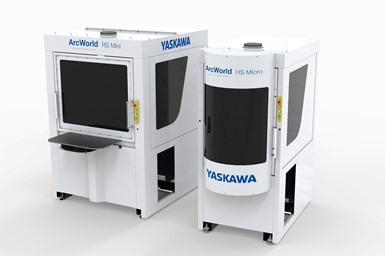Compact Workcells Integrating Into Weld Processes
IMTS22: ArcWorld releases the ArcWorld RS and ArcWorld HS, pre-engineered workcells designed for assisting with weld processes. However, these robots differ from most of their counterparts in a distinct way — they’re miniature.
Share




From Yaskawa America Inc. comes the newest models of the ArcWorld family of pre-engineered robotic arc welding workcells, the ArcWorld RS and ArcWorld HS. These mini robots are designed to deliver a flexible, compact and cost-effective option for integrating robotics into current weld processes. Suitable for replacing or supplementing manual welding, each solution is designed for optimizing small to medium-size part production for medium volume fabrication. A good application example of the robots’ capabilities, according to Yaskawa, is pre-assembly before welding in larger robotic workcells.

Photo credits: Yaskawa America Inc.
Requiring 2.3 square meters (25 sq. ft) of floor space, the ArcWorld RS utilizes a rotating station (RS) design manually indexed by the operator. It features two fixture tables with a 100 kg payload capacity per side. This facilitates quick changeover, enabling parts to be safely loaded and unloaded while the opposite station part is welded. Parts up to 425 x 700 x 990 mm can be processed.
More compact than the RS, the ArcWorld HS needs 1.4 square meters (15 sq. ft) of floor space and offers a hinged station (HS) design, enabling easy access for loading and unloading parts. The workcell features a single fixture table with a 100 kg payload capacity and can process parts up to 550 x 500 x 1050 mm in size. Yaskawa highlights this cell as being good for R&D, educational use and smaller production runs.
Despite their small stature, the safety of these robots is still important to Yaskawa. The ArcWorld RS and ArcWorld HS are safeguarded and have a completed risk assessment, compliant with ANSI/RIA R15.06-2012 and other relevant ISO and CSA standards. The robot controller’s Functional Safety Unit (FSU) uses stand-still monitoring for the robot and safety signals. All workcell doors are safety monitored.
Related Content
-
CNC Machine Shop Honored for Automation, Machine Monitoring
From cobots to machine monitoring, this Top Shop honoree shows that machining technology is about more than the machine tool.
-
Managing Coolant with Skimmers, Refractometers and More
Bacteria-infected coolant harms machines and sickens machinists. Coolant management technologies like skimmers and automated systems counter this tendency.
-
Inside the Premium Machine Shop Making Fasteners
AMPG can’t help but take risks — its management doesn’t know how to run machines. But these risks have enabled it to become a runaway success in its market.



















.png;maxWidth=300;quality=90)

.png;maxWidth=970;quality=90)